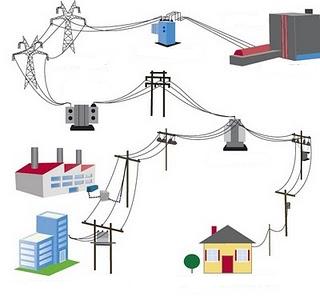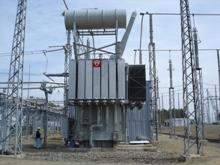Transmission and distribution of electricity
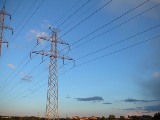 Electrical system called the electrical part of the electrical power system and powered by it receivers of electrical energy, united by the general in the process of production, transmission, distribution and consumption of electric energy.
Electrical system called the electrical part of the electrical power system and powered by it receivers of electrical energy, united by the general in the process of production, transmission, distribution and consumption of electric energy.
Currently, 74 regional systems operate in parallel as part of 6 interconnected power systems.
The electrical network is called a set of electrical installations for the transmission and distribution of electrical energy, consisting of substations, distribution devices, wires, overhead and cable power lines operating in a certain area.
A substation is an electrical installation serving the transformation and distribution of electricity and consisting of transformers or other energy converters, distribution devices up to and above 1000 V, a battery of control devices and auxiliary structures.
Distribution devices is called an electrical installation that serves to receive and distribute electricity and contains switching devices, buses and connecting buses, auxiliary devices (compressor, battery, etc.), as well as protective devices, automation and measuring devices.
Power line (PTL) any voltage (overhead or cable) is an electrical installation designed to transmit electrical energy at the same voltage without transformation.
Rice. 1. Transmission and distribution of electrical energy
According to a number of signs, electrical networks are divided into a large number of varieties, for which different methods of calculation, installation and operation are used.
Electrical networks are divided into:
a) up to 1 kV;
b) above 1 kV.
2. At the nominal voltage level:
a) low voltage networks (up to 1 kV);
b) networks with medium voltage (over 1 kV and up to 35 kV inclusive);
c) high voltage networks (110 ... 220 kV);
d) networks with extremely high voltage (330 ... 750 kV);
e) networks with ultra-high voltage (over 1000 kV)
3. By degree of mobility:
a) mobile (allow multiple route changes, folding and unfolding) — networks up to 1 kV;
b) stationary networks (have an unchanged route and structure):
-
temporary — for powering objects that work for a short time (several years);
-
permanent — most power grids that have been in operation for decades.
4. With advance registration:
 a) networks up to 1 kV: lighting; power; mixed; special (control and signaling networks).
a) networks up to 1 kV: lighting; power; mixed; special (control and signaling networks).
b) networks above 1 kV: local, serving small areas, with a range of 15 ... 30 km, voltage up to and including 35 kV; regional, covering large areas and connecting the power plants of the electrical system to each other and to load centers, with a voltage of 110 kV and more.
5. By the nature of the current and the number of wires:
a) direct current lines: single-wire, two-wire, three-wire (+,-, 0);
b) Alternating current lines: single-phase (one- and two-wire), three-phase (three- and four-wire), half-phase (two phases and zero).
6. According to the operating mode of the neutral: with effectively grounded neutral (networks above 1 kV), with solidly grounded neutral (networks up to and above 1 kV), with isolated neutral (networks up to and above 1 kV).
7. According to the circuit diagram:
a) open (unnecessary):

Oriz.2… Open circuit schemes: a) radial (load only at the end of the line); b) trunk (the load is connected to the line in different places). b) closed (redundant).
b) closed:
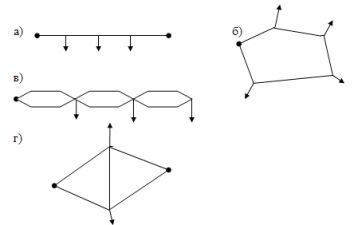
Oriz.3… Closed network diagrams: a) network with two-way supply; b) ring network; c) dual carriageway; d) complex closed network (for supply to responsible users in two or more directions).
8. By project: electrical wiring (power supply and lighting), wires — for transmitting electricity in large quantities over short distances, air lines — for the transmission of electricity over long distances, cable lines — for the transmission of electricity over long distances in cases where the construction of overhead lines is impossible.
The following requirements are imposed on electrical networks: reliability, survivability and efficiency.
Reliability — the main technical requirement, which is understood as the property of the network to fulfill its purpose within a certain time and operating conditions, providing electric consumers with electricity in the required quantity and with the appropriate quality.
The required amount of electricity is determined by the power and mode of operation of the electricity consumers. The quality of electricity depends on the parameters of the network and is determined by GOST 13109-97, which gives the permissible voltage deviations at the terminals of electrical receivers: electric motors -5% ... + 10%; working lighting lamps for industrial enterprises and public buildings, outdoor floodlights -2.5% ... + 5%; lamps for lighting residential buildings, emergency and outdoor lighting, other electrical appliances ± 5%.
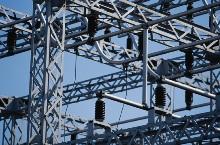 Reliability is ensured by:
Reliability is ensured by:
1. the implementation of a network diagram that takes into account the responsibility of electricity consumers;
2. selection of appropriate brands of wires and cables;
3. Careful calculation of cross-sections of heating wires and cables, permissible voltage losses and mechanical strength and calculation voltage regulating devices;
4. compliance with the technology of electrical works;
5. timely and quality implementation of the rules for technical operation.
Vitality of the electrical network — this is the ability to fulfill its purpose in conditions of destructive effects, including in a combat environment under the influence of enemy weapons.
Vitality is achieved by:
1. the use of structures that are least susceptible to destruction when exposed to the harmful factors of the enemy's weapons;
2.special network protection from damaging factors;
3. clear organization of repair and restoration works. Vitality is the primary tactical requirement.
Profitability — this is the minimum cost of building and operating the network, provided that the requirements for reliability and survivability are met.
Profitability is ensured by:
1. the use of typical mass-produced and standard designs;
2. unification of materials and equipment;
3. the use of non-deficient and cheap materials;
4. the possibility of further development, expansion and improvement during work.
I. I. Meshteryakov
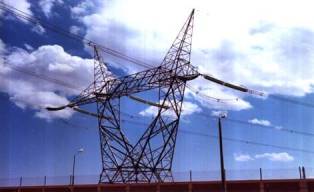 Transmission and distribution of electricity
Transmission and distribution of electricity
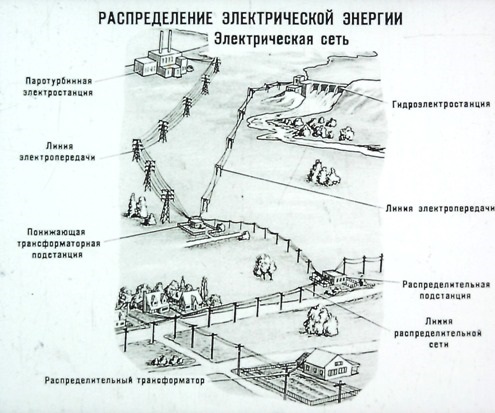 Distribution of electrical energy from an old strip
Distribution of electrical energy from an old strip

